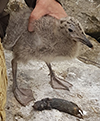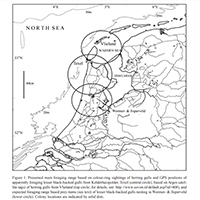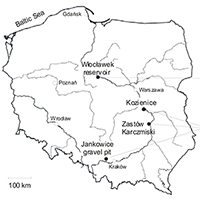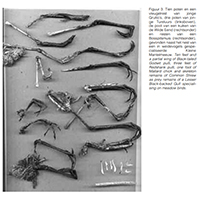 Larus cachinnans in the Netherlands
Larus cachinnans in the Netherlands
(last update: December 24, 2021)
Albert de Jong
Leon Kelder
Roland-Jan Buijs
Thijs Horst
Merijn Loeve
Mars Muusse
Cachinnans breeding in the Netherlands - food choice
| you can participate in this project too! please send in your observations of colour ringed birds to: ring@buijsecoconsult.nl |
FOOD
Each visit we payed special attention to any food left-overs in the direct vicinity of the nest. Also, when cactching chicks, their natural reaction may be to upchuck any prey. And that's exactly what some chicks did at De Kreupel and Lelystad as well.
For season 2020, we found the following food items and prey in Lelystad colony:
- Beatles
- Round Goby and Roach (fish species)
- Small mammal, a rodent
Prey found around Caspian Gull nests at colony "De Kreupel" 2021.
Fish:
- Roach
- Roach/Rudd
- Spike Perch
- Rounded Goby
- Perch
- Eel
- Russian Carp
Birds:
- Cormorant eggs
- Coot egg
- large white-headed gull egg
- pullus Grey-lagged Goose
- pullus Black-headed Gull
Food choice and competition in 3 breeding gulls: Caspian Gull, Lesser Black-backed Gull and Herring Gull.
Pellets – prey type
Food left-overs around nest
Shifting resources with chick age
| . | Lesser black-backed gull | Herring gull | ||||||
| . | Kelderhuispolder | Wormer- & Jisperveld | Kelderhuispolder | Vlieland | ||||
| Group: | n | % | n | % | n | % | n | % |
| Insects | 631 | 17.8 | 6 | 3.7 | 250 | 8.3 | 13 | 6.7 |
| Oligochaetes | 140 | 3.9 | 31 | 19.3 | 33 | 1.1 | 1 | 0.5 |
| Polychaetes | 511 | 14.4 | . | . | 65 | 2.2 | 4 | 2.1 |
| Echinoderms | . | . | . | . | 19 | 0.6 | . | . |
| Gastropods | 70 | 2.0 | 1 | 0.6 | 59 | 2.0 | 3 | 1.6 |
| Bivalves | 49 | 1.4 | . | . | 2108 | 70.2 | 126 | 65.3 |
| Cephalopods | 2 | 0.1 | . | . | 3 | 0.1 | . | . |
| Crustaceans | 783 | 22.1 | 7 | 4.3 | 435 | 14.5 | 97 | 50.3 |
| Fish | 2812 | 79.3 | 32 | 19.9 | 650 | 21.6 | 54 | 28.0 |
| Birds, non-Passerines | 304 | 8.6 | 33 | 20.5 | 265 | 8.8 | 2 | 1.0 |
| Birds, Passerines | 17 | 0.5 | 3 | 1.9 | 29 | 1.0 | . | . |
| Mammals | 32 | 0.9 | 72 | 44.7 | 82 | 2.7 | 2 | 1.0 |
| Plants | 451 | 12.7 | 4 | 2.5 | 304 | 10.1 | 5 | 2.6 |
| Seaweeds | 1 | 0.0 | . | . | 10 | 0.3 | 1 | 0.5 |
| Human waste | 209 | 5.9 | 7 | 4.3 | 477 | 15.9 | 3 | 1.6 |
| Miscellaneous | 149 | 4.2 | 3 | 1.9 | 398 | 13.3 | 28 | 14.5 |
| Sample | 3546 | . | 161 | . | 3003 | . | 193 | . |
| Table (link to PDF). Frequency of occurrence (n, %) of main prey types in pellets and regurgitated matter, as the most readily available and common source of dietary information in all study colonies. Under ‘fish’ both marine and freshwater types are included. Some very rare groups (hydroids, sponges, barnacles, and unidentified Nematoda) were not listed in this table. | ||||||||
FEEDING LOCATIONS
One of the major fish resources for breeding Caspian Gulls, both in colony De Kreupel and colony Lelystad, are the fish traps within 300 meters from teh colony.
LITERATURE
 Sterfte van schubvis als discards in de grotefuikvisserij in het IJsselmeer en Markermeer
Sterfte van schubvis als discards in de grotefuikvisserij in het IJsselmeer en Markermeer
- Ir. A.B. Griffioen en dr. N.S.H. Tien -
IMARES Wageningen UR, IJmuiden, maart 2016.
De omvang van de schubvisbijvangst in het IJsselmeer wordt vervolgens geschat op een 0.3 tot ruim 15.6 miljoen vissen. Het best guess scenario komt uit op 9.0 miljoen bijgevangen schubvis. Tussen het minimum en het maximum zit een factor 50 verschil.
Welk aandeel van de commerciële bijvangst als discards overboord wordt gezet is onbekend, maar waarschijnlijk is 90-95 van de baars en snoekbaars ondermaats en dus overboord gezet als discards. (d)
Welk aandeel van de discards sterft is ook onbekend maar zal hoogstwaarschijnlijk zeer hoog zijn. In het verleden zijn proeven gedaan waaruit blijkt dat veel vissen sterven al dan niet direct of indirect (door bijvoorbeeld wonden of door een verhoogde predatiekans).
Diet Changes in Breeding Herring Gulls (Larus argentatus) in Witless Bay, Newfoundland and Labrador, Canada, over 40 Years
-
Alexander L. Bond -
 IN: Waterbirds 39 (Special Publication 1): 152-158, 2016.
IN: Waterbirds 39 (Special Publication 1): 152-158, 2016.
The diets of gulls (Laridae) can have consequences for reproductive success, chick growth, and survival, yet there have been no quantitative assessments in eastern Newfoundland since the early 1970s. The diet of Herring Gulls (Larus argentatus) was examined through regurgitated prey items and pellets on Gull Island, Witless Bay, Newfoundland and Labrador, Canada, in 2012, and compared with similar data from 1970-1971.
There was a significant shift in Herring Gull diet composition from blue mussels (Mytilus edulis) and capelin (Mallotus villosus) in the 1970s to garbage and Common Murre (Uria aalge) eggs in 2012. Delays in capelin spawning and the large increase in breeding Common Murres on Gull Island are likely factors influencing Herring Gull diet.
Garbage, which includes human food scraps as well as plastic debris, now constitutes the single largest diet item for Herring Gulls, corresponding with a global increase in plastic pollution. The consistently low contribution of fisheries discards suggests that changes in fishing practices and availability of discards are only one possible factor in the Herring Gull decline in Witless Bay.
Habitat utilisation, feeding tactics and age related feeding efficiency in the Caspian Gull Larus cachinnans
- Piotr Skorka & Joanna D. Wojcik -
 IN: J Ornithol (2008) 149:31–39.
IN: J Ornithol (2008) 149:31–39.
The feeding behaviour of the Caspian Gull Larus cachinnans was analysed in southern Poland in 2001. During the pre-breeding period, most birds foraged on a refuse dump and some foraged in a river valley. During incubation, similar numbers of birds foraged on fishponds, gravel pits and the refuse dump. During the chick-rearing period, fishponds were the most important foraging grounds.
The foraging success of three main foraging tactics was analysed: digging on refuse, fishing and kleptoparasitism. We found that digging success was higher in juveniles than in immature or adult birds. However, older birds moved and ate more items per unit of time than juveniles, which indicates that older birds improved their energy gain simply by a higher speed of searching.
The opposite was found for fishing success. As juvenile birds made fewer attempts than immature or adult birds, fishing success was higher in adults. Adults and immature birds interrupted more attacks than juveniles, which indicates that older birds were better able to assess the probability of fish catching than juveniles. Kleptoparasitism was observed almost exclusively on the refuse dump during the pre-breeding period. Young birds kleptoparasitised more frequently than adults, but they had a lower rate of success. However, the lower success in young birds was due to victim choice, rather than differences in flight skills. Young birds kleptoparasitised Black-headed Gulls Larus ridibundus and Jackdaws Corvus monedula more frequently than adults, but none of the attacks towards these species was successful. Generally, Caspian Gulls kleptoparasitised conspecifics more often than expected from species frequency. Only attacks towards conspecifics yielded any success.
Reproductive parameters of Caspian Gull Larus cachinnans Pallas, 1811 in different habitats nearby and away fish ponds
-
Robert GWIAZDA, Grzegorz NEUBAUER, Jacek BETLEJA, Łukasz BEDNARZ, Magdalena ZAGALSKA-NEUBAUER -
 IN: Pol. J. Ecol. (2015) 63: 159–165.
IN: Pol. J. Ecol. (2015) 63: 159–165.
Reproductive performance of gulls depends on a variety of factors, but food abundance and its availability are among the most important. Clutch and egg sizes in gulls are found to be strongly influenced by food availability, thus better reproductive performance in the colony with greater fish availability (near fish ponds) was expected in that study. We compared the reproductive traits (clutch size, volume of eggs in the full clutch, relative volume of the C-egg (the third egg in gull’s clutches) and hatching success) of Caspian Gull Larus cachinnans in five inland colonies in Poland located at a gravel pit, a lake, a river and two dam reservoirs.
Differences in the clutch size between sites were found, with the lowest at a lake. We found similar clutch volume in all studied colonies. C-eggs were slightly smaller than A- and B- eggs, in all colonies and all study years, but the relative volume of C-egg in colonies located near fish ponds (<10 km) was significantly greater compared to colonies located far away.
This may be explained by high fish availability in fishponds in comparison to other habitats.
However hatching success (the ratio of the number of hatched chick to the number of eggs laid) was highest in the colony at the lake. This indicates that both inland habitats a gravel pit and a lake offered good food conditions for large gulls when fish ponds are nearby.
Bijvangsten in de fuiken-visserij op het IJsselmeer publ: DLO-Rijksinstituut voor Visserijonderzoek - November 1993 In het kader van een studie naar de effecten van de beroepsvisserij op de commercieel geëxploiteerde soorten en de overige in het ecosysteem aanwezige vis, en vogels, worden in dit rapport gegevens gepresenteerd betreffende de bijvangst in de fuikenvisserij. In de tachtiger jaren werden door het RIVO experimenteel fuiken geplaatst in het IJsselmeer, terwijl in de negentiger jaren vangsten in de fuiken van de commerciële visserij werden bemonsterd. |
Mammalian prey in Laridae: increased predation pressure on mammal populations expected
The occurrence of mammalian prey in the diet of two species of large gulls, the Herring Gull (Larus argentatus) and the Lesser Black-backed Gull (Larus fuscus), was investigated in order to quantify and compare the predation on mammals in coastal and inland colony sites. Specialised coastal nesting birds and a majority of individuals in an inland colony were found to feed on mammals frequently. |
|
- Robert Gwiazda, Dariusz Bukaciñski, Grzegorz Neubauer, Marcin Faber,Jacek Betleja, Magdalena Zagalska-Neubauer, Monika Bukaciñska& Przemys³aw Chylarecki - IN: Ornis Fennica 5(2): 91-170 - January 2011. |
Diet of Lesser Black-backed Gulls Larus graellsii in a Dutch inland colony
|
Evaluating gull diets: a comparison of conventional methods and stable isotope analysis IN: J. Field Ornithol. 82(3):297–310, 2011.
|
 Food choice. When trapped for ringing, this chick upchucked a small rodent.
Food choice. When trapped for ringing, this chick upchucked a small rodent. Pullus Caspian Gull Larus cachinnans F|B of "nest 002" which has 8CY PNED as one of the parents, May 16 2019, Lelystad, the Netherlands.
 Food choice: a chick threw up a Round Goby (a fish species of shallow water), which is most likely 'natural prey'.
Food choice: a chick threw up a Round Goby (a fish species of shallow water), which is most likely 'natural prey'. Caspian Gull Larus cachinnans of "nest 038", with chick F|G and chick F|H May 21 2020, Lelystad, the Netherlands.
 Food choice: Roach and Eel, two fish species, which are common by-catch in fish traps, therefore 'easy food' for the gulls.
Food choice: Roach and Eel, two fish species, which are common by-catch in fish traps, therefore 'easy food' for the gulls. Caspian Gull Larus cachinnans of "nest C06" at De Kreupel, the Netherlands.
 Food choice. When trapped for ringing, this chick threw up a melee of beatles.
Food choice. When trapped for ringing, this chick threw up a melee of beatles. Pullus Caspian Gull Larus cachinnans F|U of "nest 029", May 21 2020, Lelystad, the Netherlands.
 Food choice: pullus Black-headed Gull as prey of Caspian Gull.
Food choice: pullus Black-headed Gull as prey of Caspian Gull. Caspian Gull Larus cachinnans of "nest M06" at De Kreupel, the Netherlands.
 Fishermen empty the fish traps, which are a major food source for breeding Larus cachinnans at Lelystad.
Fishermen empty the fish traps, which are a major food source for breeding Larus cachinnans at Lelystad. Food resources: what do they eat and where do they feed?
Food resources: what do they eat and where do they feed? Questions to better understand why Caspian Gull is doing well here.
A bird predating on a goose chick, April 23 2021, De Kreupel. Picture: Merijn Loeve.
 Food resources: what do they eat and where do they feed?
Food resources: what do they eat and where do they feed?
Questions to better understand why Caspian Gull is doing well here.
Is kleptoparasitism on Cormorants the secret strategy? April 23 2021, De Kreupel. Picture: Merijn Loeve.

 Diet composition of the Caspian Gull (Larus cachinnans) in inland Poland:
Diet composition of the Caspian Gull (Larus cachinnans) in inland Poland: 
